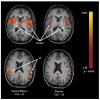Widespread hyperalgesia in irritable bowel syndrome is dynamically maintained by tonic visceral impulse input and placebo/nocebo factors: evidence from human psychophysics, animal models, and neuroimaging
- PMID: 19375508
- PMCID: PMC2844701
- DOI: 10.1016/j.neuroimage.2009.04.028
Widespread hyperalgesia in irritable bowel syndrome is dynamically maintained by tonic visceral impulse input and placebo/nocebo factors: evidence from human psychophysics, animal models, and neuroimaging
Abstract
Irritable bowel syndrome (IBS) is a highly prevalent gastrointestinal disorder that is often accompanied by both visceral and somatic hyperalgesia (enhanced pain from colorectal and somatic stimuli). Neural mechanisms of both types of hyperalgesia have been analyzed by neuroimaging studies of IBS patients and animal analog studies of "IBS-like" rats with delayed rectal and somatic hypersensitivity. Results from these studies suggest that pains associated with both visceral and widespread secondary cutaneous hyperalgesia are dynamically maintained by tonic impulse input from the non-inflamed colon and/or rectum and by brain-to-spinal cord facilitation. Enhanced visceral and somatic pains are accompanied by enhanced pain-related brain activity in IBS patients as compared to normal control subjects; placebos can normalize both their hyperalgesia and enhanced brain activity. That pain in IBS which is likely to be at least partly maintained by peripheral impulse input from the colon/rectum is supported by results showing that local rectal-colonic anesthesia normalizes visceral and somatic hyperalgesia in IBS patients and visceral and somatic hypersensitivity in "IBS-like" rats. Yet these forms of hyperalgesia are also highly modifiable by placebo and nocebo factors (e.g., expectations of relief or distress, respectively). Our working hypothesis is that synergistic interactions occur between placebo/nocebo factors and enhanced afferent processing so as to enhance, maintain, or reduce hyperalgesia in IBS. This explanatory model may be relevant to other persistent pain conditions.
Figures




References
-
- Accarino AM, Azpiroz F, Malagelada JR. Selective dysfunction of mechanosensitive intestinal afferents in irritable bowel syndrome. Gastroenterology. 1995;108:636–643. - PubMed
-
- Al Chaer ED, Kawasaki M, Pasricha PJ. A new model of chronic visceral hypersensitivity in adult rats induced by colon irritation during postnatal development. Gastroenterology. 2000;119:1276–1285. - PubMed
-
- Bar M, Aminoff E, Mason M, Fenske M. The units of thought. Hippocampus. 2007;17(2007) - PubMed
-
- Bouin M, Meunier P, Riberdy-Poitras M, Poitras P. Pain hypersensitivity in patients with functional gastrointestinal disorders: a gastrointestinal-specific defect or a general systemic condition? Dig. Dis. Sci. 2001;46:2542–2548. - PubMed
-
- Chang L, Mayer EA, Johnson T, FitzGerald LZ, Naliboff B. Differences in somatic perception in female patients with irritable bowel syndrome with and without fibromyalgia. Pain. 2000;84:297–307. - PubMed
Publication types
MeSH terms
Substances
Grants and funding
LinkOut - more resources
Full Text Sources

